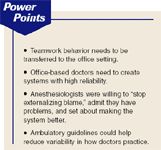Article
Is this the way to lower malpractice rates?
Anesthesiologists have reduced their premiums by focusing on safety. But is that a realistic model for primary care and other doctors to follow?

In June, The Wall Street Journal published a complimentary piece on how the specialty has managed to shake off its once-risky reputation, with a payoff that other specialties might be wise to take note of. Reported the Journal: By focusing on improving patient safety rather than on "laws that would protect them from patient lawsuits," anesthesiologists have succeeded in lowering their malpractice premiums significantly-to the point where they "pay less for malpractice insurance today, in constant dollars, than they did 20 years ago."
Other news outlets have also sung the specialty's praises, including this magazine. In our comprehensive med-mal report, published this past January, we quoted California risk-management consultant David Karp, who said, bluntly: "If other specialists would follow the anesthesiologists, you'd see a dramatic drop in claims, and, therefore, premiums."
Taking a hard look in the mirror
A patient-safety crisis hit anesthesiology even before the term entered the American lexicon.
By the early1980s, two in every 10,000 patients who went under anesthesia died, frequently because doctors had no reliable ways of measuring things like pulse rate, respiration, and carbon dioxide levels. In 1970, nearly 8 percent of all closed malpractice claims were against anesthesiologists, who even today make up only 4 percent of all US physicians. The number of closed claims involving permanent disability or death was also disproportionately high during this period-about 64 percent-and so was the number of closed claims with payment.
As a result of all this bad news, malpractice rates for anesthesiologists soared, especially during the med-mal crises of the 1970s and early 1980s. In 1985, their average malpractice premium was $18,112, according to the American Society of Anesthesiologists. In inflation-adjusted dollars, that's about 59 percent more than they pay on average today.
The rate crisis caught the specialty's attention. Like their colleagues in other branches of medicine, anesthesiologists wanted their liability premiums reduced. "But key leaders understood that the remedy wasn't just about tort reform but about finding better ways to take care of patients," says anesthesiologist David M. Gaba, associate dean for immersive and simulation-based learning at the Stanford University School of Medicine.
For many, that meant taking a long, hard look in the mirror, admitting that patient safety was imperfect, and that the specialty as a whole had to be enlisted in the turnaround if real progress was to be made. "Suddenly, you could make your career in the anesthesia business as a safety expert," Gaba says. "Safety became a legitimate part of the overall endeavor."





